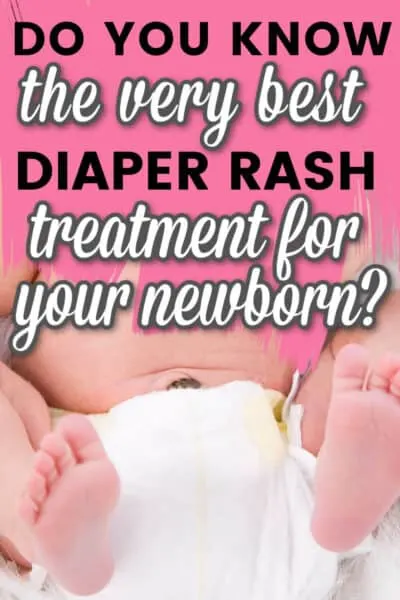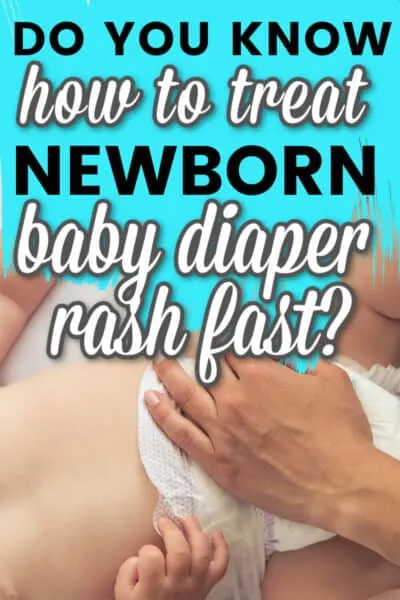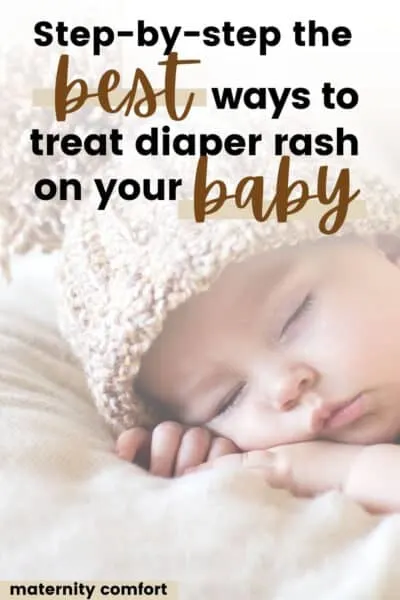Updated October 26, 2023
Are you desperately scouring the internet looking for diaper rash treatment for infants?
You are not alone.
Most parents find themselves fighting the battle of diaper rash at some point.
Diaper rash is one of the most common skin issues that newborns and infants develop. It affects up to 65% of babies at some point during their first year. (Source)
So don’t think you did anything wrong if your baby develops a diaper rash.
Diaper rash treatment for infants goes beyond just creams and includes:
- Change the dirty diaper right away.
- Using proper diaper changing techniques.
Turns out there is both an art and science to preventing and treating diaper rash.
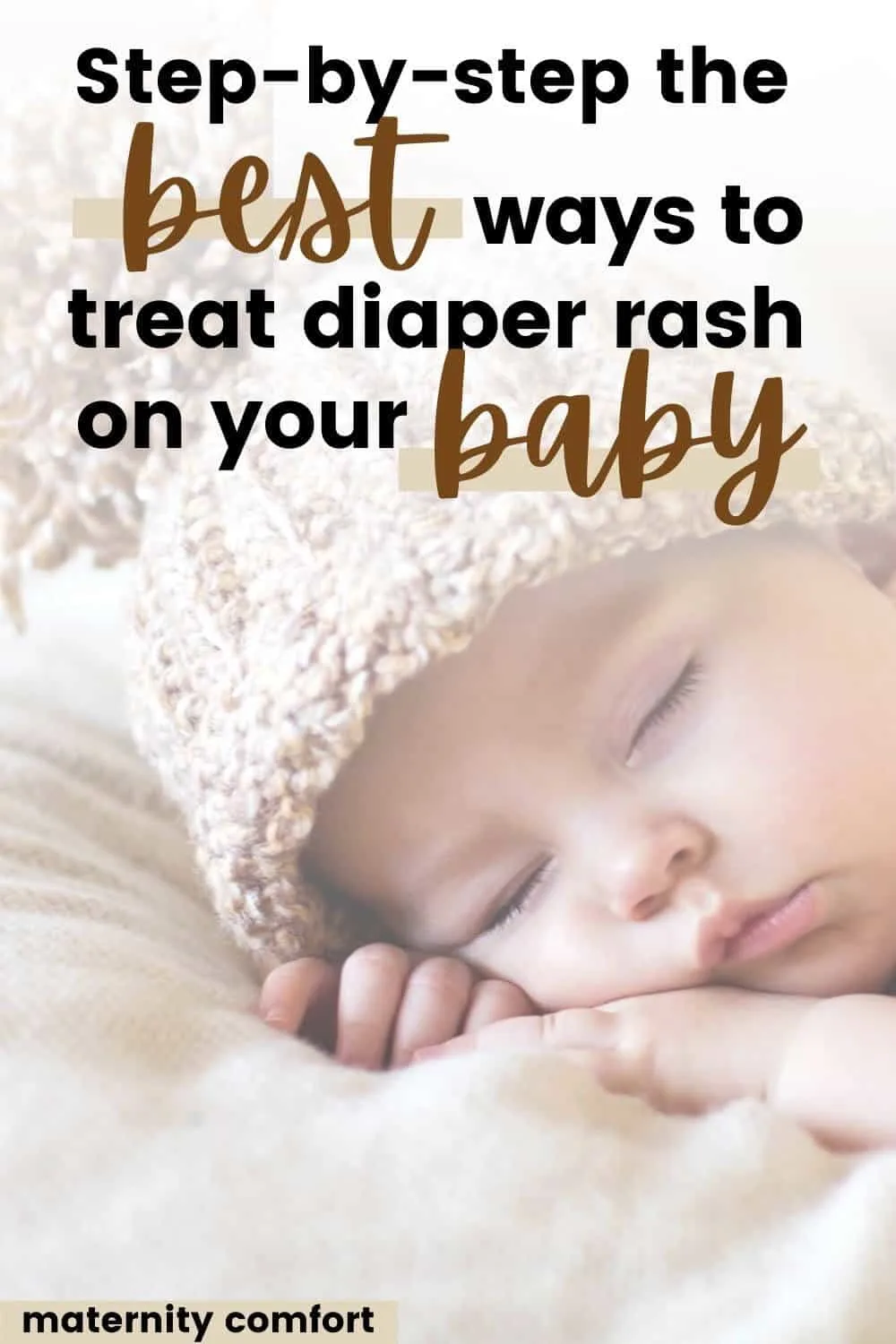
There are many creams on the market claiming to rid babies of the pain and discomfort associated with diaper rash.
However, many parents may be surprised to discover that the best thing to do for a child with a diaper rash may begin before the cream is even applied.
Effective Diaper Rash Treatment For Infants Starts With Timing
Changing a dirty diaper as soon as possible is where diaper rash treatment for infants begins.
Other factors may become necessary to manage a diaper rash but preventing further irritation is essential.
Once your child has a diaper rash, sitting in a dirty diaper for any amount of time will delay healing and can make the rash worse.
If the skin breaks down, there is also a risk of developing a secondary bacterial infection.
Cleaning your baby’s bottom correctly is critical because a baby’s skin is very delicate and sensitive.
It doesn’t take much to irritate the skin which can lead to more problems.
Cleaning Treatment for Diaper Rash
Parents can let the diaper rash air-dry in order to help the skin heal.
But other options may be necessary to effectively treat the condition.
The severity of the diaper rash will determine the cleaning process.
For the diaper rash that is persistent, but not causing your baby to scream during every diaper change, cleaning with warm water (not baby wipes), air-drying along with a good diaper cream will be suitable.
However, if the skin condition makes your baby scream with every change, you will need to consider different methods (below) depending on the severity of the rash.
Best Diaper Rash Treatment Instruction Step-by-Step:
This treatment combines the air-dry method with other methods to help lessen skin irritation on the baby’s bottom.
1. Before the diaper change begins, start a warm water bath in a sink or tub and add a couple of teaspoons of baking soda.
Baking soda helps to neutralize the acids from feces that are on the baby’s bottom and helps lessen the irritation of the rash.
2. Remove the baby’s diaper along with as much waste as can be wiped off using the diaper itself.
No wipes are needed. It is best to not use baby wipes if your infant has a diaper rash.
3. Let the babysit in the warm water/baking soda bath for as long as needed.
The baby will hopefully be comfortable in the bath. If the baby appears to be in pain, add cold water to minimally reduce the temperature of the water.
4. When the baby is done soaking in the warm water bath, he should be taken from the bath and laid down.
This is the time that the baby’s bottom needs to be assessed for any poop that may not have come off during the soak.
A bulb syringe filled with water left from the soak can be used to squirt off the baby’s bottom to ensure that there is nothing left over.
5. After the soak and bulb syringe procedures are completed, the baby’s bottom needs to dry for a few minutes prior to cream and diaper application.
NOTE: It is very important to take the time to perform the steps listed above. Do not rush when you are preparing the affected area.
You want your baby’s bottom prepared properly for the cream application and diapering.
Thoroughly soak and use the syringe to further clean the area.
Rubbing the rash with a cloth or wipe or leaving any dirt behind will only cause irritation and possibly lead to a bacterial infection.
When our kids were infants we would use this time while waiting for them to completely dry as an opportunity to snuggle.
We occasionally had to deal with a toddler diaper rash and our toddler diaper rash remedy was the same.
It is an ideal time to read them a book and have a cuddle time too.
When treated properly, diaper rashes rarely become a serious problem.
Once the area is clean, allow the skin to air dry completely.
Moist skin is a breeding ground for yeast.
This is the main reason why the focus when treating a diaper rash is to make sure the affected area is dry.
Then, when the cream is applied it will act as an oily or greasy barrier to repel moisture, including water, urine, or diarrhea.
Best Diaper Creams for Diaper Rash
There are many diaper creams on the market to treat diaper rash.
But not all babies react the same way to each cream. Some creams may heal some babies and do nothing for others.
There are two basic types of diaper rash creams:
- Creams used to help keep the diaper rash from getting wet. This type of cream is for maintenance.
- Treatment creams, when a diaper rash needs to heal.
A few suggestions for highly recommended diaper rash ointments
Bag Balm is a very popular lanolin-based, skin moisturizer that has been around for many years. When applied, it keeps skin soft and maintains a layer of protection.
Aquaphor Baby Healing Ointment
Advanced Therapy for Diaper Rash, Chapped Cheeks, and Minor Scrapes – 14. Oz Jar
Aquaphor Baby Healing Ointment
Formulated by a pharmacist and pediatrician.
Many pediatricians recommend this ointment not only for the treatment of diaper rash but also to help prevent it from recurring.
Burt’s Bees Baby Bee Diaper Ointment
For parents who prefer to use all-natural products, this ointment is 100% natural and contains sweet almond oil.
It uses vitamins, chamomile, along with other natural ingredients to help soothe and moisturize the delicate baby bottom.
Burt’s Bees Baby Bee Diaper Ointment
Using The Best Diaper Rash Treatment is Worth the Effort.
It may seem that the best way to treat diaper rash is time-consuming, but it really is not.
When it comes to the overall health and comfort of a baby, there is no procedure too time-consuming.
The best way to treat a diaper rash is by responding quickly to a dirty diaper, using a baking soda soak for every diaper change, and applying creams to help soothe irritated skin.
For a happy baby, the time and treatment invested are worth it.
By far, the most important piece of advice is to try and prevent a diaper rash whenever possible by changing a dirty diaper as soon as you can.
An ounce of prevention is definitely worth a pound of cure when it comes to managing a diaper rash.
Types of diaper rash
Diaper rashes share one common factor, they are almost always associated with increased moisture next to your baby’s skin.
This allows chemical irritants or infectious organisms to develop rashes.
Though diaper rash is treated the same initially and most often resolves, it is important to know that diaper rashes can have more than one cause.
The reason it is essential to be familiar with the different types of diaper rash is that you want to know what to do if the rash persists or worsens once treated.
Within a reasonable period of time, when you are managing a medical condition, you want to observe improvement.
Dermatologists who deal with rashes extensively are well aware of the fact that their diagnosis of a rash can be incorrect and only by monitoring the response to treatment, can they be sure they have made the correct diagnosis.
One more important note is to realize that a rash can be a combination of two types of rashes.
The best example of this is irritant dermatitis which gets severe enough to cause the skin to break down and result in a rash due to a bacterial infection.
1. Irritant Dermatitis
This is the most common type of diaper rash and is caused by irritation of the skin because it has been in contact with urine or stool.
This rash can be most severe when your baby has diarrhea and is teething because of the effect of excess saliva passing through the digestive tract.
Irritant Dermatitis
Irritant dermatitis is a type of contact dermatitis.
As we will discuss, there are other forms of contact dermatitis that can cause a diaper rash.
Though the best diaper rash treatment for infants with irritant dermatitis is prevention, even if you are meticulous about promptly and properly changing diapers this form of diaper rash is likely to occur occasionally.
2. Candida or Fungal Dermatitis:
Fungal dermatitis is another very common cause of diaper rash and can occur over many parts of the body at any age.
The most common way to determine if a diaper rash is due to fungal infection is the appearance of the rash.
There are diagnostic tests that can be done to look for yeast. However, if you suspect a fungal infection, a trial of treatment with an antifungal cream will give you an answer rather quickly.
Yeast rashes often resolve very fast when treated with a topical ointment.
First, you might want to try the many non-medicinal options that are available but don’t hesitate to contact your pediatrician if the rash does not improve, so you can be prescribed a safe antifungal cream for diaper rash
Yeast (fungal) infections occur where the skin is covered over, not exposed to air, and warm and moist.
These areas are often in skin creases where the skin surfaces are in constant contact.
Mucous membranes are also susceptible to yeast infections as is seen with oral thrush.
The external skin areas on your baby that are most susceptible to yeast infections are under the arms and in the groin and genital area.
How Do You Treat Fungal Diaper Rash?
Once you have determined that your baby has a fungal diaper rash that is not resolving, you will want to contact your pediatrician to ask about using an anti-fungal cream prepared for the management of diaper rash treatment in infants.
Though the anti-fungal creams are available for adult use, the diaper rash creams and ointments do not have anti-fungal medication.
There are many natural creams available for fungal diaper rash.
If you choose one of these creams initially, make sure to consult your pediatrician if you do not see improvement. Fungal rashes respond quickly once treated.
Fortunately, if a diaper rash is carefully managed by keeping the area dry and covered with barrier ointment, yeast can resolve without anti-fungal medication.
Most important is to recognize a fungal infection as soon as possible so you can prevent a severe rash that will require further treatment and take longer to heal.
HELPFUL TIP: How To Determine If A Diaper Rash Is Getting Better Or Worse?
There are two ways dermatologists monitor a rash to determine if it is responding to treatment.
These methods are extremely simple and yet very helpful:
1. Gently place a mark at the outer edge of the rash using a non-toxic marker (see below).
If you make a mark, you will not have to remember how the rash looked from one diaper change to the next

2. Use your smartphone or any camera and take a picture of the rash from the same place each day.
By comparing the pictures, you will be able to determine if the rash is spreading.
In addition, if you first mark the rash (above) it will be easier to show the changes to your pediatrician.
3. Allergic Dermatitis
Diaper rashes that arise from an allergic reaction are not uncommon and can be related to many substances that come in contact with your baby’s skin.
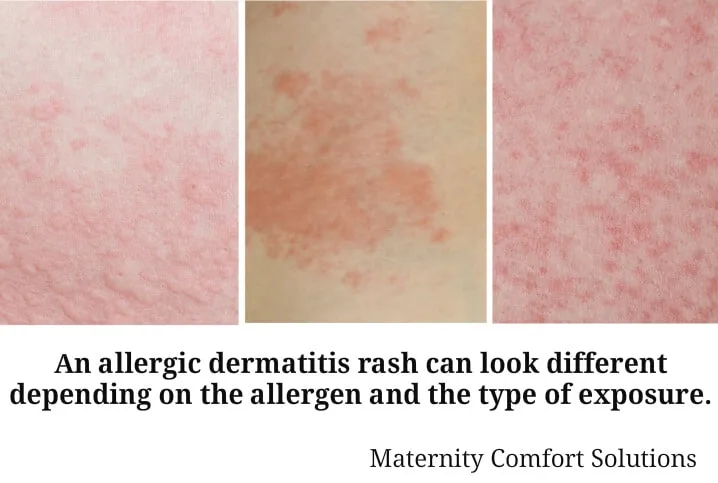
The list can be extensive as allergic reactions of all types are very common.
The appearance of an allergic rash differs based on the allergen and the type of exposure.
The following are some of the more common allergens you will want to be familiar with when it comes to diaper rash treatment for infants.
If you can simply identify the allergen the problem is solved.
It may require some trial and error to identify the cause:
- Soaps of all kinds (especially soaps that are scented)
- Laundry detergents used to wash cloth diapers
- Scented disposable diapers
- Diaper creams
Scented items can be particularly problematic.
To avoid allergic dermatitis (especially if your baby has sensitive skin), use hypoallergenic products.
The easiest way to determine if your baby has an allergic diaper rash is to see if the rash is well-demarcated.
The rash will be located directly where the allergen is in direct contact with the skin.
4. Bacterial Dermatitis
This form of diaper rash through the least common can be the most severe.
It can occur when the integrity of the skin surface has been affected allowing infection with staph or strep.
When this type of rash occurs it must be evaluated by your pediatrician and treated with a topical or oral antibiotic.
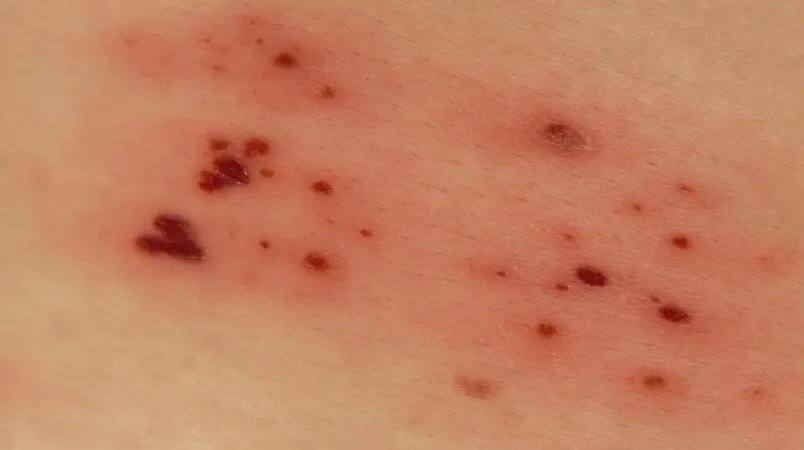
Bacterial Dermatitis
A bacterial diaper rash can happen regardless of how careful you are with diaper care.
It can occur if a common irritant dermatitis causes the skin to break down.
Tight-fitting diapers:
Though tight-fitting diapers or clothing may not be a type of diaper rash, they can contribute to the development of a diaper rash.
This can be a result of poor air circulation or a result of rubbing and chafing which will make the skin more susceptible to irritants
Have questions about other newborn rashes?
11 Common Baby Rashes: A Mom’s Quick Guide
.
You will also become familiar with able to manage diaper rashes and will know when to seek further assistance.
If you apply the steps for diaper rash treatment for infants. and the rash persists after you have applied the best treatment for diaper rash as outlined above.
Common Diaper Rash Questions:
With an estimated 28 billion disposable diaper changes (not including cloth diapers) in the United States each year, it is no surprise there are many diaper rash questions, especially among first-time parents. Source
What cures diaper rash fast?
A rapid cure for diaper rash starts with keeping your baby’s bottom clean and dry and immediately applying a barrier cream (Zinc Oxide or Petroleum Jelly) to stop further irritation.
The next step is to determine what kind of rash your baby rash so you can be sure you are treating the rash correctly. This is where a lot of time can be lost.
If a rash is not improving with standard treatment, do not hesitate to consult with your pediatrician. You may need to include other treatments such as an anti-fungal cream or antibiotic.
What does a typical diaper rash look like?
The illustrations above are intended to give an idea of what a “typical” rash looks like. Since many rashes will appear similar at the beginning, it is important to look for any changes in appearance.
Since a diaper rash is an irritant contact dermatitis, the skin changes associated with a typical diaper rash will be located where urine or stool on the diaper is in direct contact with the skin.
The folds of skin in the groin region will often be spared, unlike yeast infections which are located in skin folds where the skin is warm, moist, and covered over.
How long do diaper rashes last?
There are three main factors that will determine how long a diaper rash will last:
- Early recognition
- Correct diagnosis
- Proper treatment
What causes a diaper rash?
Diaper rash is caused by irritation of the skin in contact with irritating urine and stool. Though urine-soaked diapers are more common, stool-soiled diapers are often more irritating.
This is especially true if your baby has diarrhea or is teething.
Should a barrier cream be used at every diaper change?
This is an individual decision. Many parents will choose to use diaper cream (zinc oxide) prior to putting on a new diaper for no reason other than prevention.
Others may use a diaper cream after an initial episode of diaper rash or if their baby has very sensitive skin.
When should I become concerned about a diaper rash?
Changes that should raise concern:
- no sign of improvement after treatment for 24 to 458 hours
- rash spreading past the diaper area while being treated
- skin starts to break down, bleed or develop any drainage (possible bacterial infection)
- the rash extends into creases and folds (possible fungal infection)
- signs of sickness (fever, lethargy)
What is the best treatment for a severe diaper rash?
Once a severe diaper rash is evaluated by your pediatrician, the best treatment will depend on the diagnosis:
- Severe diaper rash – mild topical steroid treatment (hydrocortisone cream)
- Fungal infection – antifungal cream
- Bacterial infection – antibiotic (topical or oral)
Is a bath helpful when managing a diaper rash?
Bathing in warm water with a tablespoon of baking soda is the best first step to managing the pain and irritation associated with a diaper rash.
Are there foods that cause diaper rash?
There are some foods that can produce irritating (acidic) stool.
To determine if a food is causing irritant dermatitis (diaper rash), remove only that food from your baby’s diet, and see if there is an improvement.
The following foods are known to be potential causes of irritation and diaper rash:
- Strawberries and other berries
- Citrus (fruits and fruit juices)
- Pineapple
- Tomatoes (tomato sauce)
- Grapes and raisins
Are there foods that can help with diaper rash?
Though the following foods will not lower stool acidity, they can help control diarrhea which is a major cause of diaper rash:
- Toast
- Bananas
- Rice
How long can my baby stay in a poopy diaper?
Though you will most often want to change a stool-soiled diaper as soon as possible, if your baby is sleeping you can wait 2 to 3 hours.
A stool-soiled diaper is more acidic than urine so you do not want to wait too long.
Final Thoughts:
Diaper rash treatment for infants always starts out the same.
Make sure the area is thoroughly clean and allowed to air dry completely.
Once you establish a diaper-changing routine, you will become confident in changing your baby’s diapers.

